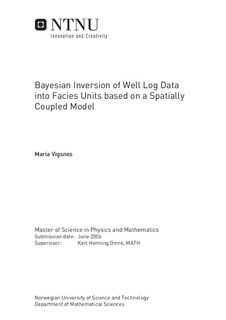| dc.contributor.advisor | Omre, Karl Henning | nb_NO |
| dc.contributor.author | Vigsnes, Maria | nb_NO |
| dc.date.accessioned | 2014-12-19T13:57:46Z | |
| dc.date.available | 2014-12-19T13:57:46Z | |
| dc.date.created | 2010-09-04 | nb_NO |
| dc.date.issued | 2006 | nb_NO |
| dc.identifier | 348364 | nb_NO |
| dc.identifier | ntnudaim:1371 | nb_NO |
| dc.identifier.uri | http://hdl.handle.net/11250/258346 | |
| dc.description.abstract | Through a study of cored wells from the Statfjord Formation in the Tampen Area, we derive a spatially coupled classification model for facies units. We consider a Bayesian framework for the problem. A likelihood model is defined from the log-response of the formation, where response from neighbour observations are considered. A first order Markov chain prior model is estimated from the cores. From the posterior pdf, the marginal maximum posterior solution can be calculated and simulations can be generated. Since the posterior pdf can be factorized, it can be calculated by a recursive Forward-Backward algorithm for hidden Markov models. The classification model is complex, and if the model assumptions does not coincides with the underlying model, the classification might give poor results due to the large number of estimated model parameters. The results from the classification of a blind well were not as good as we expected, but gave good results for the small classes, compared to a classification model without spatial coupling. | nb_NO |
| dc.language | eng | nb_NO |
| dc.publisher | Institutt for matematiske fag | nb_NO |
| dc.subject | ntnudaim | no_NO |
| dc.subject | SIF3 fysikk og matematikk | no_NO |
| dc.subject | Industriell matematikk | no_NO |
| dc.title | Bayesian Inversion of Well Log Data into Facies Units based on a Spatially Coupled Model | nb_NO |
| dc.type | Master thesis | nb_NO |
| dc.source.pagenumber | 99 | nb_NO |
| dc.contributor.department | Norges teknisk-naturvitenskapelige universitet, Fakultet for informasjonsteknologi, matematikk og elektroteknikk, Institutt for matematiske fag | nb_NO |

